Our Tips for Riding A Motorcycle Safely in America – read on.
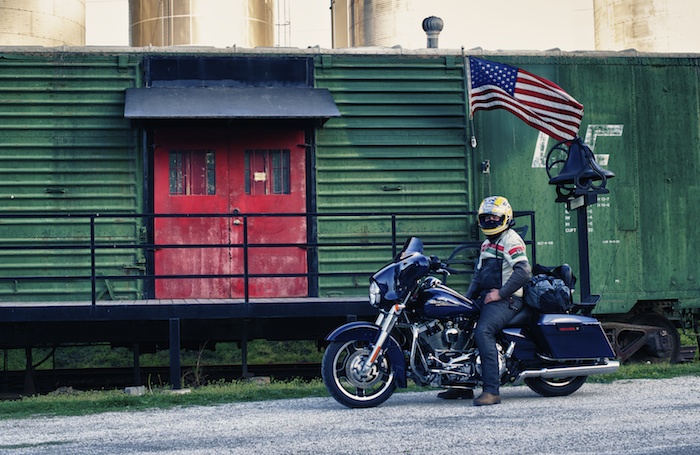
Plan Ahead, Be Alert and Have A Great Time Riding in America
So, you’ve finally decided to do it, you’ve booked your dream tour to America, riding down Route 66, the Pacific Coast Highway, Yellowstone, Sturgis or one of the many beautiful places to see by motorcycle. Even if you’re a highly experienced rider at home, hiring a big touring bike and dealing with the unique dynamic of American roads and drivers can be challenging. We’ve learned a few things over the 100,000+ miles we’ve ridden in the USA, and we thought we’d share our 7 Tips for Riding A Motorcycle Safely in America, so you can have the best and safest time on your guided or self drive tour or rental. Here goes:
1: Distracted Driving is An American Epidemic
Riding in America, it’s simply shocking how many drivers you see texting, talking on the phone, doing their makeup, eating – anything but concentrating on the road. It’s the worst on highways around heavily populated areas – on a recent ride into L.A., Tim and I were riding along and were overtaken by a car on each side, going 85 mph in a 70 zone, one driver had his hands thru the steering wheel texting, the other was staring down in her lap texting. When you’re riding in less populated areas like on Route 66, or the National Parks where speed limits are enforced harshly, it’s not as much as a worry. But generally speaking, you’ll encounter more distracted drivers than in Europe. What can you do about it? Drive defensively. Assume that cars don’t see you, and if you do see a driver texting, get away from them, perhaps by letting them pass. Riding a motorcycle requires an enhanced level of situational awareness at all times, but when you absolutely know a driver isn’t paying attention, you need to be ready for anything – cover your clutch and brake, check your speed, and wait until numpty drives off.
2: Being on Holiday Isn’t An Excuse Not To Wear Proper Safety Gear
It’s a bit odd how often we see this – riders who have 1000cc sport bikes at home, Arai helmet & full Alpinestars kit, but when they come to America and ride a Harley, it’s a t-shirt, jeans, and a pisspot helmet. There’s a temptation to look the part, ride free and all that, but just because you’re on holiday doesn’t mean you should leave your safety kit at home. In fact, because you’re riding in what is likely an unfamiliar environment, proper safety gear is even more important. For us, that means a full face helmet, abrasion resistant jacket and trousers, preferably with armor, over the ankle boots, and gloves that fully cover the wrist. A back protector is a good idea as well. Al this gear doesn’t look as cool as bare arms, wraparound shades and the wind in your hair, but nobody who ever had an incident on a bike ever wished they were wearing less safety gear.
3: Familiarize Yourself With The Hire Bike
The overwhelming majority of hire bikes in the US are Harley Davidson, although we can get you a Honda GoldWing, BMW GS & RT, Triumph Bonneville and more from EagleRider. Unless you ride the exact same model back home, it’s likely that there will be some key differences in each of the hire models. Some have fork locks separate from the ignition; some have ABS that needs a few feet before they set; some have heel and toe shifters, and they all have turn signals in different locations! Also, even among the different Harleys, ground clearance varies. If you ride a sport touring bike back home, you may be shocked at how much less ground clearance is available on a touring bike with floorboards. So take some time and get truly acclimated to your hire bike, know where all the switches are, what they do. Get a sense of the brake strength and ground clearance – don’t wait until you need to know this information before you know it. Take it slow for the first day or two, don’t rush it, make sure you “click” with your hire bike.
4: Don’t Allow Yourself To Get Distracted
With all the great scenery you’ll be seeing on your tour, it’s sometimes a struggle to pay attention to the road while taking it all in – but it’s really important that you do. Decreasing radius corners are often not adequately marked, even on roads like the Pacific Coast Highway; if you’re distracted, you can easily be surprised. We sometimes see riders playing with the radio, or their gloves, MP3 player, GPS – you cannot do this safely, especially when riding in a group. It’s best to pull over, take your time with whatever you’re doing, and catch back up to the group safely. Typically you are provided with contact and destination information on Guided Tours, plus there’s a chase vehicle that stays at the back of the group, so don’t worry about getting lost or left behind.
5: Ride In Staggered Formation
When you’re riding in a group, it’s essential that you ride in staggered formation. Riding “staggered” is fairly simple: if the rider in front of you is in the left side of the lane, you ride one second behind, to the right (or vice-versa). This provides plenty of stopping room, without another bike directly in front of you. On tight, twisty roads, it’s very difficult to ride staggered, so instead ride single file, with a two second gap to the rider in front. What you don’t want to EVER do is follow directly in the wheel tracks of the rider in front of you, close and at high speeds. Always leave yourself some space if you have to maneuver or brake hard. Now sometimes in large groups on open roads, you’ll find the rider in front of you either rides smack in the middle of the lane, or does not hold a consistent place in the lane, making it impossible to ride staggered behind. In this case, drop back several seconds and give yourself space.
Here’ a visual illustration of staggered formation riding from the Motorcycle Safety Foundation:
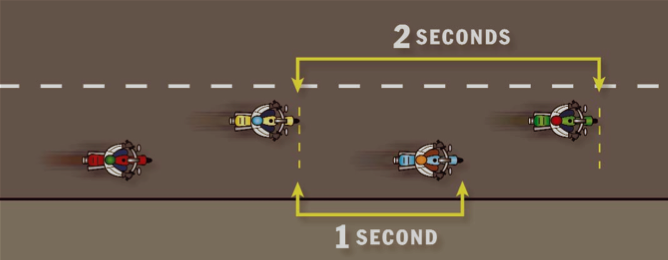
6: Be Conscious of What’s Behind You
Remember the distracted driver or rider we mentioned earlier? If you’re stopped at a traffic light, and they’re fiddling with something, there’s a good chance they might not notice the light and be able to stop in time. It’s incredibly important, especially at traffic lights and when riding in large groups, to be aware of what’s happening behind you, and be ready to accelerate if you need to. As often as possible, keep your motorcycle in gear when stopped at a light, and have an escape route planned – you obviously don’t want to ride straight out into traffic!
7: Riding On The Right (Wrong) Side Of The Road
If you’re from the UK, OZ or SA, it’s going to take a short bit to get used to riding on the other side of the road. All your reactions, where you look for traffic, which lane you get in after a turn – you’ll be riding in an entirely counterintuitive world. It’s amazing how easily the brain adapts, and most people get it by the end of day one. But we have seen a few people have a hard time with it on the first day. If you’re riding on a Guided Tour, and have never ridden on the opposite side of the road, consider coming in and picking up your bike a day early to practice. Getting used to this “mirror riding” on your own, without a large tour group around you can be money well spent, as you’ll be that much more confident on day one of the tour.
So there you have it – some basic Tips for Riding A Motorcycle Safely in America, or really, anywhere in the world. It’s not rocket science, it’s all simple stuff, information that experienced riders probably know intrinsically. But some of us can get a bit lazy about safety on holidays, and it’s good to refresh the basics. Hope you found this information helpful!
If you’re interested in hiring a motorcycle in America, or doing a Guided or Self-Drive tour, contact us! We’re Official EagleRider Tour Operators with great prices.
– Jim

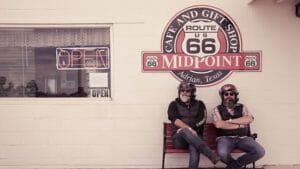
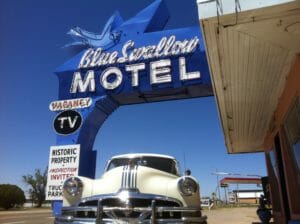
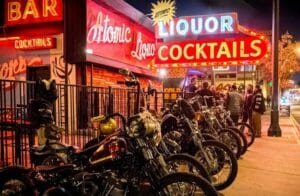
Yer very good advise and a great Idea to help International riders with riding in the US . Cheers ,
Cheers Grant, glad you found it helpful!
Best,
Jim
Great advice and thank you. I have a daughter who lives in Minnesota(MN) to whom we pay regular visits and drive whilst in USA. I ride a Harley Street Glide (Screeming Eagle 1800cc) here in UK and can testify that it’s a very different ride to most other motorcycles. My ‘bike’ weighs just over half a ton and the stopping advice and riding in or out of formation is applicable in UK but as you correctly state, USA driving adds another dimension and it seems ‘yanks’ don’t give a damn about care for other road users! Undertaking is prevalent but in MN is not allowed, but because of the way the americans weave about I wouldn’t recommend it. Having said that, in UK there is a reluctance, on motorways, for drivers to use the correct lanes for fear of getting stuck without the opportunity to move lanes? Quite often motorcycles are habitually using ‘in between’ lane manoeuvres due to thoughtless car drivers.
Keep safe y’all – happy biking.
Thanks Stan, yeah the general level of driving ability in the USA is below the UK because the education is nowhere near as comprehensive, nor mandatory to get a license. There are a lot of barely skilled drivers on the road, and many are distracted at that. Got to pay attention at all times especially in traffic. One of the things we loved about riding Route 66 is we hardly ever saw other drivers.
Best,
Jim
look left…get some tape and put it on the bike someplace in your vision..I forgot, and paid the price…in perham, minnesota. The road feels exactly the same in the states as it does at home. Especially when your sliding along it.
Yeah too true Jonesy, gotta be careful with that. Hope you didn’t slide too long (!)
Great article.Thankyou for sharing.I was recently in Indianapolis and was shocked to see dudes on bikes doing 120 m/h on an intersate with NO gear No Helmet …nothing.Here in South Africa we have a phrase called:All Gear At All Times.
Rather keep your head and hands ,body intact than look cool…and THINKBIKE
Yeah Steve there are a few States in the USA with no helmet law – as to the guys doing 120 with no helmet, I guess it’s all part of Darwinian evolution 🙂
good advise for any place riding a bike is to remember ,that nearly any one in a car wont mind if they run over or into you so if you dont want to be a victim
always keep a eye on them
Most people are not that callous Lee, but many are that careless, so yes, you have to pay attention at all times. But that’s true no matter where in the world you’re riding……
Jim
Yes I do all that here
Riding motorcycles carries a natural vulnerability that we as riders must recognise and manage in our own country. When we travel abroad, we must familiarise ourselves with the Road Law as it applies and then ensure that our holiday does not deteriorate into a negative life-changing experience. I agree with all that said and having travelled Europe and America for many years, protective clothing is a must in all climates – the choice we give our Tour participants is easy – “A shower or a skin graft”. ArriveSafe folks.
Yep, all sensible advice. I’ve driven once and ridden twice across the US, the last time on a three months trip. I have to say driving standards in the US surpass those in the UK. Here it is almost impossible not to have traffic ahead or behind you throughout the day, whereas in the US, the freedom of wide open spaces is fantastic. You talk about safety clothing yet that worn by US riders in the main is awful. Bandanas, fingerless gloves, stupid high handlebars and feet forward riding positions. Riding wearing trainers.
I loved the US, the wide open spaces and the fact I DIDN’T need to concentrate every second of every hour of every day.
Paul – not sure when or where you rode in the USA, of course there are some areas that are open with little traffic, however: the driver education and licensing system in the USA is nowhere near as comprehensive as in the UK. Having ridden many miles in both countries over many years, we can safely say that drivers in the UK are far more respectful and aware of motorcycles than US drivers. And the riders themselves are trained far better in the UK than in the USA as well, with a higher level of awareness about how to ride safety, including what to wear.
That said: Tim’s from the UK, I’m from the USA. We both are competent, highly experienced riders, we both wear proper clothing when we ride. There’s no passport that automatically makes someone a capable, safe rider, we’ve seen good and bad riders from all over the world.
Lastly – there’s no time, no country, no place when we’re riding a motorcycle and are NOT concentrating every second of every hour of every day. We stay frosty at all times.
Jim McDermott
I’m from the UK, but have ridden in the USA on holiday. Three main differences I found: 1. Traffic lights; they are in the middle of the cross roads, not at the stopping place as in the UK. If you stop at the lights, you are in the middle of the junction! 2. Undertaking; this is illegal in the UK, but standard procedure in the USA. 3. Filtering between lanes of stationary traffic (I think it’s called lane sledging in the USA). Normal procedure in the UK. Illegal in the USA.
All good points Andy, thanks for posting! Small correction, Filtering is legal in California, but yes, everywhere else it it not.
Best,
Jim
Thanks for the advice guys. I am a relatively new rider having bought my first Harley (and first bike) in Saudi Arabia in 2011. I rode in and around Riyadh only on Friday mornings (Islamic Sinday) as there were few drivers on the road, but believe me if you’ve survived the driving experience in Saudi Arabia then driving in the US and Europe is relatively plain sailing. I have seen cars enter roads at 180kmh, loose control and just about take out our Road Captain; drivers reversing back up the middle lane of the motorway because they missed the turn-off and the next one is 2km away (yes really, they do not seem to be phazed by this). And then there is the numpties who like to play ‘chicken’ with motorcycles. Luckily I had only one incident which was totally my fault – that cost me a bust leg and several months of treatment (all ok now and back on my Fat Bob).
I hope to do a USA trip this year (2014) and I appreciate all the info from The Lost Adventure guys. If I end up coming out alone I will definitely give you guys a call regarding a guided tour. Thanks and ride safe.